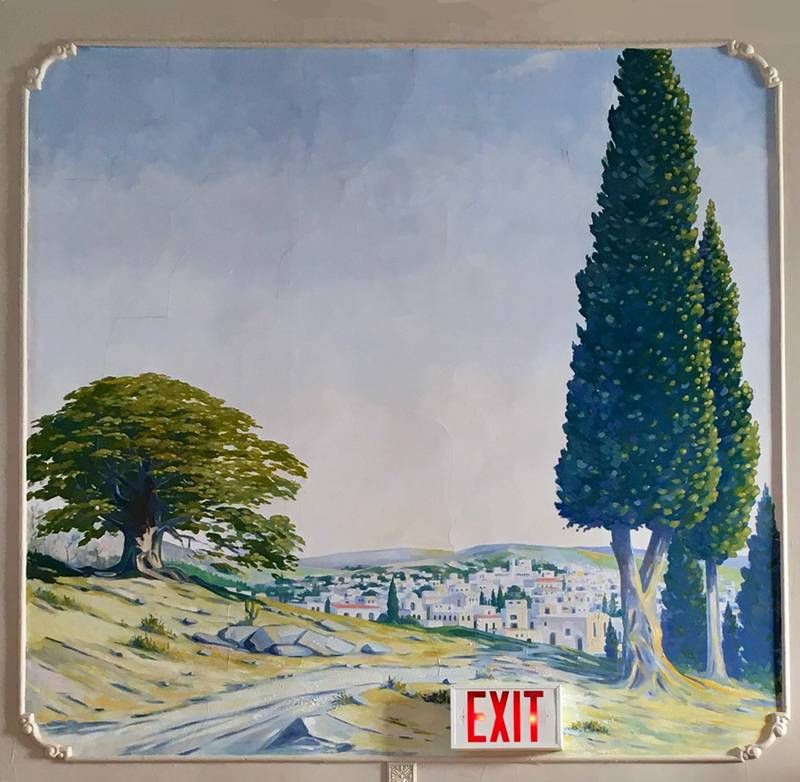Wilma Kenny | Feb 01, 2023
In Grace Hall in Sydenham, there’s a large unsigned picture painted directly on the wall, above the front entrance. It shows a road curving toward a small town far in the distance.
Those who notice such things with curiosity have wondered who painted it, and why. Lacking answers, some have tried to fill the gap with speculation that soon became accepted as fact. The road has been identified as local, in spite of the small cactus by the rock pile on the left and the dome-roofed all-white buildings in the background. A glaring red “exit’ sign has been cut into the bottom of the picture, and the paint on the lower part of the picture is beginning to flake off .
Here’s what I remember: some time in the early 50’s, the Jonassens arrived from Denmark to join our small farming community just east of Sydenham.
Desperate for somewhere to live, Ole worked hard to persuade one of our neighbours to let him move into an old derelict frame house on their property which was so run-down that it was being used as a hay barn. It didn’t have insulation, electricity or running water: there were two small rooms and a woodshed on the ground floor, probably two small bedrooms upstairs, a big wood stove that took up a quarter of the kitchen and an outhouse. None of the other houses and farms had running water either, and we used outhouses, but we at least grew most of our own food, had electricity, and all the men had secondary jobs in area plants, mills or factories. Ole was an artist. How could an artist ever support a wife and four children?
He began by painting every inside surface of the house with soft, warm colours: peach, pink, mauve, blue, green, yellow. He hung paintings of the home they had left, and the countryside around it. Even as a child, I had trouble reconciling the small, irritable, homesick man with the beautiful oasis he had created.
It wasn’t long before Ole became well known in Kingston for his large wall murals which usually depicted local historical scenes (Fort Henry and the Kingston skyline were favourites). Most of them have vanished over the years, as properties were sold and renovated. He painted in restaurants, stores and fraternal halls - Morrison’s, Steacy’s, Oddfellows, Masons, etc. The stone hall at the corner of Johnson & Wellington may still have some of his work. He taught oil painting at SHS night school. He under-painted in light purple, a quality that made his work immediately identifiable.
Ole was hired to renovate the interior of Grace United Church (now Grace Hall), when the basement was being dug out and a kitchen added downstairs. He was given pretty much carte blanche by the congregation, and he transformed an austere meeting-hall: built a raised dais at the front with choir spaces on each side, and two pulpits rich with carving. The walls were pale pastels, but the wainscotting and pews (which had all been ugly brown false-grain) were khaki: “So people will be encouraged to look up,” he explained.
At the front, where there remains an arch with a cross on top, hung a huge painting of Christ praying in Gethsemane, derived from Heinrich Hoffman’s work, but in much lighter colours than the original.
And on the back wall of the church, Ole painted a picture of the road to Bethlehem. Neither painting was signed.
More Stories
- No Winner Yet in Catch The Ace But Fundraising Target Met
- South Frontenac Food Bank Opens Second Location in Battersea
- Sharbot Lake Pentecostal Church Anniversary - 1925-2025
- Frontenac Holistic Health Fair - September 20 At Storrington Centre
- Odd Year For Real Estate - But Sales Are Steady Year Over Year
- 193rd Kingston Fall Fair
- Kim Phuc - the Napalm Girl - To Visit Flinton In November
- South Frontenac Council - September 2
- Sticker Shock - EV Charging Station To Cost North Frontenac Township
- 30th Anniversary Verona Car Show

